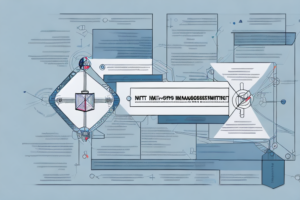What is RMF compliance?

A computer system with a shield around it
RMF compliance refers to complying with the Risk Management Framework standards established by the National Institute of Standards and Technology (NIST). These standards define a rigorous process for identifying, assessing, and prioritizing risks associated with an organization’s information systems, as well as implementing security controls to mitigate these risks.
Understanding the basics of RMF compliance
The basic principle behind RMF compliance is that an organization must identify its assets and the risks associated with them. This includes identifying the potential vulnerabilities in the systems, and assessing the potential consequences of exploitation of these vulnerabilities. Once identified, these risks must be prioritized and appropriate security controls must be implemented to mitigate each of the identified risks.
RMF compliance is a continuous process, and risk management should be ongoing throughout the entire system lifecycle, from development to operation. This means that the risk management process must be flexible and adaptable to the changing risks associated with the systems throughout their lifespan.
It is important to note that RMF compliance is not just a one-time event, but rather an ongoing process that requires regular monitoring and evaluation. This includes conducting regular risk assessments, reviewing and updating security controls, and ensuring that all personnel are trained and aware of their roles and responsibilities in maintaining compliance. Additionally, organizations must be prepared to respond to security incidents and breaches, and have a plan in place to quickly and effectively mitigate any potential damage.
Why is RMF compliance important for your organization?
The consequences of a security breach can be severe, and can include loss of data, damage to reputation, and significant financial costs. Compliance with RMF standards helps organizations to not only identify and assess potential risks, but to also implement appropriate security measures to mitigate these risks. This helps to improve overall security posture, protect valuable assets and information, and comply with regulatory requirements.
Furthermore, RMF compliance can also help organizations to gain a competitive advantage in the marketplace. Customers and partners are increasingly concerned about the security of their data and are more likely to do business with organizations that can demonstrate a strong commitment to security and compliance. By achieving RMF compliance, organizations can differentiate themselves from their competitors and build trust with their stakeholders.
Finally, RMF compliance is an ongoing process that requires regular monitoring and updates. By implementing RMF standards, organizations can establish a culture of continuous improvement and ensure that their security measures remain effective over time. This can help to prevent future security breaches and minimize the impact of any incidents that do occur.
The history and evolution of RMF compliance
The history of RMF compliance can be traced back to the early days of computer security and government regulations. The Department of Defense (DoD) established a set of security guidelines in 1985, which eventually evolved into the current standard known as the NIST Risk Management Framework. The RMF was created in response to the increasing complexity and interconnectivity of computer systems, and to provide a unified framework for risk management across all government agencies.
Over the years, the RMF has undergone several revisions and updates to keep up with the changing threat landscape and technological advancements. In 2018, NIST released the latest version of the RMF, which includes new guidelines for supply chain risk management and privacy considerations.
Today, RMF compliance is not just limited to government agencies, but also extends to private organizations that handle sensitive information. Many industries, such as healthcare and finance, have adopted the RMF as a best practice for managing cybersecurity risks. Compliance with the RMF not only helps organizations protect their assets and reputation, but also ensures that they are meeting regulatory requirements and industry standards.
Different types of RMF compliance frameworks
There are various frameworks that organizations can use to achieve RMF compliance, including the NIST RMF, the DoD RMF, and the Intelligence Community (IC) RMF. Each of these frameworks provides a set of guidelines and procedures for identifying, assessing, and mitigating risk, but they may also have slight differences depending on the specific agency or industry.
For example, the NIST RMF is widely used in the federal government and provides a standardized approach to risk management across agencies. The DoD RMF, on the other hand, is tailored specifically to the Department of Defense and includes additional security controls and requirements. The IC RMF is used by intelligence agencies and includes unique considerations for protecting classified information.
A step-by-step guide to achieving RMF compliance
The process for achieving RMF compliance can be broken down into six distinct steps: categorization, selection, implementation, assessment, authorization, and continuous monitoring. Each step is essential for identifying and mitigating risks, and ensuring compliance with regulatory requirements. It is important to note that the RMF process is iterative and continuous, and may require ongoing adjustments and updates as systems evolve and new risks are identified.
One of the key challenges in achieving RMF compliance is ensuring that all stakeholders are aware of their roles and responsibilities throughout the process. This includes not only IT and security personnel, but also business owners and other stakeholders who may be impacted by the implementation of security controls. Effective communication and collaboration between all parties is critical for ensuring that the RMF process is successful and that compliance is achieved in a timely and efficient manner.
Common challenges faced during RMF compliance and how to overcome them
Some of the common challenges faced during RMF compliance include lack of resources or expertise, difficulty in prioritizing risks, and implementing complex security controls. Organizations should consider partnering with experienced RMF consultants to help guide them through the compliance process, building a strong internal team, and developing a comprehensive risk management plan that is well-documented, understood, and communicated throughout the organization.
Another challenge that organizations may face during RMF compliance is the lack of understanding of the RMF process and its requirements. This can lead to confusion and errors in the compliance process. To overcome this challenge, organizations should invest in training and education for their employees on the RMF process and its requirements. This will help ensure that everyone involved in the compliance process has a clear understanding of their roles and responsibilities, and can work together effectively to achieve compliance.
How to choose the right RMF compliance consultant for your organization
When selecting an RMF compliance consultant, it is important to choose a firm that has experience working with organizations in your industry and has a deep understanding of the specific regulatory requirements that apply to your organization. Additionally, look for firms that have a proven track record of success and strong references from their past clients. Finally, consider the consultant’s approach and methodology to ensure that it aligns with your organization’s needs and culture.
Another important factor to consider when choosing an RMF compliance consultant is their level of communication and collaboration. The consultant should be able to effectively communicate with your organization’s stakeholders and work collaboratively with your team to ensure that everyone is on the same page and that the compliance process runs smoothly.
It is also important to consider the consultant’s level of flexibility and adaptability. The regulatory landscape is constantly changing, and your organization’s needs may evolve over time. Look for a consultant who is able to adapt to these changes and can provide ongoing support to ensure that your organization remains compliant in the long term.
Best practices for maintaining RMF compliance
To maintain RMF compliance, organizations should focus on building a strong risk management culture, constantly assessing and addressing new risks, and regularly reviewing and updating their risk management plans. Regular training and awareness sessions should be conducted to ensure that all employees understand the importance of RMF compliance, as well as their individual roles and responsibilities in achieving and maintaining compliance.
It is also important for organizations to establish clear communication channels and reporting mechanisms for identifying and addressing potential compliance issues. This includes implementing a system for employees to report any concerns or violations, as well as conducting regular audits and assessments to identify areas for improvement. By prioritizing RMF compliance and taking proactive measures to address potential risks, organizations can ensure the security and integrity of their systems and data.
Benefits of achieving and maintaining RMF compliance
The benefits of achieving and maintaining RMF compliance include a stronger security posture, improved risk management, regulatory compliance, and increased trust and confidence among stakeholders. Additionally, organizations that achieve RMF compliance can qualify for government contracts and other business opportunities that require compliance with specific security regulations. Ultimately, RMF compliance can help an organization to protect its valuable assets, reputation, and bottom line.
Furthermore, achieving and maintaining RMF compliance can also lead to cost savings in the long run. By implementing effective security controls and risk management practices, organizations can reduce the likelihood and impact of security incidents, which can be costly to remediate. In addition, compliance with RMF can help organizations avoid fines and legal penalties for non-compliance with security regulations. Overall, the benefits of RMF compliance extend beyond just improving security and can have a positive impact on an organization’s financial health.
Impacts of non-compliance with RMF regulations
The consequences of non-compliance with RMF regulations can be severe, and can include fines, penalties, loss of business opportunities, and damage to reputation. Additionally, non-compliance can increase the risk of security breaches, which can result in the loss of valuable assets and information. Organizations that fail to comply with RMF regulations may find themselves at a significant competitive disadvantage in their respective industries.
Furthermore, non-compliance with RMF regulations can also lead to legal action and lawsuits from affected parties, such as customers or stakeholders. These legal battles can be costly and time-consuming, and can further damage the organization’s reputation. It is important for organizations to prioritize compliance with RMF regulations to avoid these negative impacts and ensure the security and protection of their assets and information.
Future trends and developments in the field of RMF compliance
The field of RMF compliance is constantly evolving, and organizations must stay up-to-date on the latest trends and developments in the field. One of the key trends in RMF compliance is the increasing use of automation and machine learning to identify and mitigate risks. Additionally, as systems become more complex and interconnected, the field of RMF compliance will need to develop new methods and tools for assessing and managing these risks.
Real-life examples of successful implementation of RMF compliance
There are many examples of successful implementation of RMF compliance across a range of industries and sectors. For example, the Department of Defense has successfully implemented the DoD RMF across its various agencies and organizations, resulting in improved security posture and compliance with regulatory requirements. Additionally, many organizations in the healthcare and financial services industries have successfully implemented the NIST RMF to protect critical assets and information.
Tips for streamlining your organization’s RMF compliance efforts
To streamline your organization’s RMF compliance efforts, consider using automated tools and technologies that can help to identify, prioritize, and mitigate risks more efficiently. Additionally, consider building a strong internal team and culture of risk management, and continually evaluating and optimizing your risk management plans and procedures.
How to prepare for an audit of your organization’s RMF compliance
Preparing for an audit of your organization’s RMF compliance involves ensuring that all necessary documentation is up-to-date, accurate, and well-documented. Additionally, ensure that all employees who have a role in RMF compliance are aware of the audit process and their respective roles and responsibilities. Finally, consider conducting a mock audit to identify any areas of weakness or potential non-compliance before the actual audit takes place.



